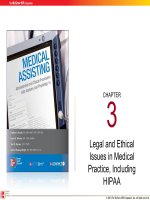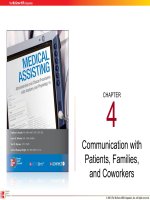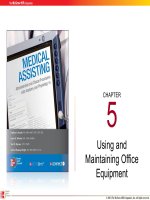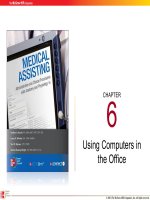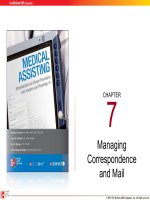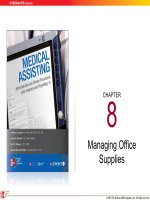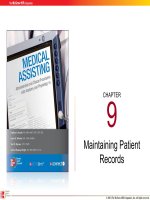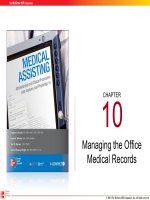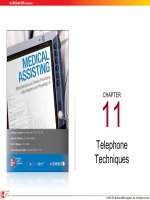Lecture Medical assisting: Administrative and clinical procedures with anatomy and physiology (4e) – Chapter 13
Bạn đang xem bản rút gọn của tài liệu. Xem và tải ngay bản đầy đủ của tài liệu tại đây (1.33 MB, 37 trang )
CHAPTER
13
Patient Reception
© 2011 T he McGraw -Hill Com panie s, Inc. A ll rights reserv ed.
13-2
Learning Outcomes
13.1 Identify the elements that are important in a
patient reception area.
13.2 Discuss ways to determine what furniture is
necessary for a patient reception area and
how it should be arranged.
13.3 List the housekeeping tasks and equipment
needed for this area of the office.
© 2011 T he McGraw -Hill Com panie s, Inc. A ll rights reserv ed.
13-3
Learning Outcomes (cont.)
13.4 Summarize the OSHA regulations that pertain
to a patient reception area.
13.5 List the physical components associated with
a comfortable and accessible patient
reception area.
13.6 List the physical components associated with
a safe and secure patient reception area.
© 2011 T he McGraw -Hill Com panie s, Inc. A ll rights reserv ed.
13-4
Learning Outcomes (cont.)
13.7 List the types of reading material appropriate
to a patient reception area.
13.8 Describe how modifications to a reception
area can accommodate patients with special
needs.
13.9 Identify special situations that can affect the
arrangement of a reception area.
© 2011 T he McGraw -Hill Com panie s, Inc. A ll rights reserv ed.
13-5
Introduction
• Patient reception
areas
– Inviting and functional
– Special needs of
disabled patients
– Pleasant and wellplanned
• Successful interaction
between patient, doctor,
and other medical staff
© 2011 T he McGraw -Hill Com panie s, Inc. A ll rights reserv ed.
13-6
First Impression
• The reception area
– Creates an impression
of whether the practice
is successful or
outdated
– Windows are not
soundproof
• Minimize noise and
conversation behind
them
– Avoid the term “waiting
room”
© 2011 T he McGraw -Hill Com panie s, Inc. A ll rights reserv ed.
13-7
Reception Area
• Medical office information
– Business cards of all physicians in office
– General practice information
• Lighting
– Fairly bright
• Avoid trips
• Needed for reading
• Conveys impression of cleanliness
© 2011 T he McGraw -Hill Com panie s, Inc. A ll rights reserv ed.
13-8
Reception Area (cont.)
• Room temperature
– Average comfortable
temperature
• Music – calming and
soothing in background
– If room is too cold or
too hot, wait seems
longer than it is
– Geriatric practice
• Warmer
© 2011 T he McGraw -Hill Com panie s, Inc. A ll rights reserv ed.
13-9
Decor
Use a group of
colors that work
well together
Consider the mood
you want to create
Items that add a
special touch
Items that may
interest patients
that are waiting
Always keep safety in mind when placing
items in the reception area.
© 2011 T he McGraw -Hill Com panie s, Inc. A ll rights reserv ed.
13-10
Furniture
• Seating
– Firm, comfortable, safe, and
easy to get in and out of
– Washable, fireproof fabric
– Should contrast with the
carpet color
• Prevent accidental falls
– Sufficient to accommodate
the number of patients,
family members, and friends
during a 2-hour time period
© 2011 T he McGraw -Hill Com panie s, Inc. A ll rights reserv ed.
13-11
Furniture (cont.)
• Arranging furniture
– Allow maximum floor space
for patient comfort
– 12 sq. ft. of space/person
• Ensuring privacy
– Placing chairs in corners
allows some privacy
– Interim rooms are great space for private
discussions with patients
© 2011 T he McGraw -Hill Com panie s, Inc. A ll rights reserv ed.
13-12
Furniture (cont.)
• Accommodating
children
– Child-size chairs and
play furniture are
needed in pediatric
offices
– Separate reception
areas for well and sick
or contagious
children
© 2011 T he McGraw -Hill Com panie s, Inc. A ll rights reserv ed.
13-13
Apply Your Knowledge
Imagine that you are working in the reception area of
the medical office and most of the patients waiting to be
seen are between the ages of 19 and 30. Would it be
appropriate to put on a mixture of heavy metal and rap
music? If yes, why? If no, why not?
ANSWER:
A. Yes
B. No
Correct!
The purpose of the music is to soothe and
calm patients. Also, although “most”
patients are in this age group, not all are, so
this type of music is inappropriate for the
reception area.
© 2011 T he McGraw -Hill Com panie s, Inc. A ll rights reserv ed.
13-14
The Importance of Cleanliness
• Maintain a high standard of cleanliness
• Housekeeping – use OSHA guidelines
– Professional service
• May need to leave detailed instructions
– Office staff
• Use appropriate antibacterial agents and vacuum
– Clean daily with emergency cleanups as needed
© 2011 T he McGraw -Hill Com panie s, Inc. A ll rights reserv ed.
13-15
The Importance of Cleanliness (cont.)
• Housekeeping
– Tasks
• Check throughout the day
• Spot-clean and straighten items
– Equipment
• Vacuums, mops, brooms
• Trash bags, cleaning solutions,
rags, buckets
• Gloves
© 2011 T he McGraw -Hill Com panie s, Inc. A ll rights reserv ed.
13-16
The Importance of Cleanliness (cont.)
Cleaning stains
Remove stains quickly by spot-cleaning spills
Removing odors
Odors are offensive in a doctor’s office
Steps to minimize odors:
Invest in a good ventilation system with charcoal filters
Disinfectant and deodorant sprays are helpful
Display “No Smoking” signs
© 2011 T he McGraw -Hill Com panie s, Inc. A ll rights reserv ed.
13-17
The Importance of Cleanliness (cont.)
Infectious waste
Vomit and blood are infectious wastes
Proper cleaning and disposal are required
OSHA regulations
Regular cleaning of walls and floors
Use of disinfectants to combat bacteria
Broken glass must be disposed of using tongs or a brush
and dustpan
© 2011 T he McGraw -Hill Com panie s, Inc. A ll rights reserv ed.
13-18
Apply Your Knowledge
A patient is coming to see the physician because of
bleeding at the surgical site (right upper thigh). While the
patient is waiting in the reception area, the blood gets into
the chair cushion of the patient’s seat. What should the
medical assistant do in this situation?
ANSWER: Put on gloves and remove the chair from the
reception area immediately. Special cleaning procedures
based on OSHA guidelines must be followed when handling
blood and body fluids.
© 2011 T he McGraw -Hill Com panie s, Inc. A ll rights reserv ed.
13-19
The Physical Components
• Office access
– Parking arrangements
• On-street vs. off-street
• Free parking lots improve
access
–
Well-lit
– Entrances
• Clearly marked
• Wide enough to
accommodate wheelchairs
and walkers
© 2011 T he McGraw -Hill Com panie s, Inc. A ll rights reserv ed.
13-20
The Physical Components (cont.)
• Safety and security
– Building exits
• Ideally, two exits to outside
• Clearly labeled with illuminated red
“Exit” signs
– Smoke detectors
• Must sound an alarm by law
• Check routinely
– Security systems
• Valuable protection
• Office staff should be familiar with
the system
© 2011 T he McGraw -Hill Com panie s, Inc. A ll rights reserv ed.
13-21
Apply Your Knowledge
It is not adequate simply to have smoke detectors in a
medical office. What responsibility does the office staff have
related to smoke detectors?
ANSWER: Office staff must routinely check the smoke
detectors to be sure they are functioning properly and must
know what to do in the event the smoke detector alarm
sounds, i.e., how to evacuate patients safely from the
building.
Good Answer!
© 2011 T he McGraw -Hill Com panie s, Inc. A ll rights reserv ed.
13-22
Reading Materials
• Magazines and books
– Select reading
materials for both
adults and younger
children that may be
of interest to them.
– Publications should be
screened for medical
content.
– Remove outdated
materials
© 2011 T he McGraw -Hill Com panie s, Inc. A ll rights reserv ed.
13-23
Reading Materials (cont.)
• Patient information packets
– The physicians in the medical practice
– Billing practices
– Insurance processing practices
• Medical Information – brochures and pamphlets
– Read and validate accuracy before placing them in
the reception area
– Be aware of content and be prepared to answer
questions patients may ask after reading these items
© 2011 T he McGraw -Hill Com panie s, Inc. A ll rights reserv ed.
13-24
Reading Materials (cont.)
• Bulletin board
– Change at intervals
– Do not allow board to
become cluttered
– Tailor information to
patient interest
– Display current
information and
remove outdated
materials as soon as
possible
© 2011 T he McGraw -Hill Com panie s, Inc. A ll rights reserv ed.
13-25
Keeping Patients Occupied and Informed
More common in reception areas
Informative health videos
Toys, videos, and books
Avoid balls, jump ropes, and other toys that are disruptive
All toys should be easy to clean avoid stuffed animals
© 2011 T he McGraw -Hill Com panie s, Inc. A ll rights reserv ed.

